Tablecloths for the kitchen: varieties and choices
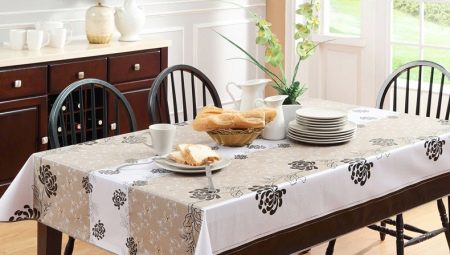
The kitchen table needs a tablecloth, which is necessary to protect its surface from damage and give the interior style, decorativeness and personality. In previous years, our mothers and grandmothers used oilcloth tablecloths, replacing them on holidays with cotton or linen. Modern housewives have a much wider choice - today women have the opportunity to choose from a large number of options for material, size and configuration.
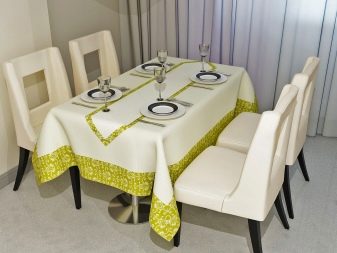
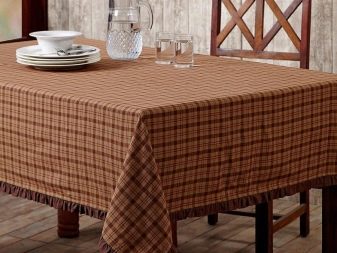
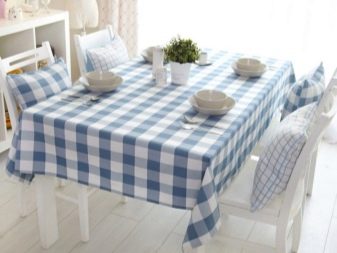

Manufacturing materials
A variety of materials are used for sewing tablecloths. Let's dwell on the advantages and disadvantages of the main ones.
Oilcloth is the most practical and cheapest option. Oilcloth on the table is considered a popular option for everyday use. The appearance of such a product cannot be called presentable - it is too simple and rude. However, the coating reliably protects the surface from liquids, grease stains and knocks from kitchen appliances. The price for such material is very affordable, therefore you can always buy several suitable models at once, changing them as needed or according to your mood.
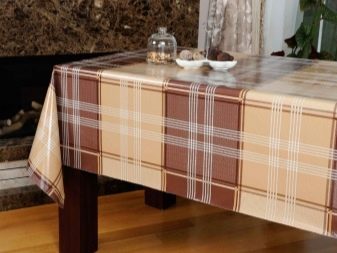
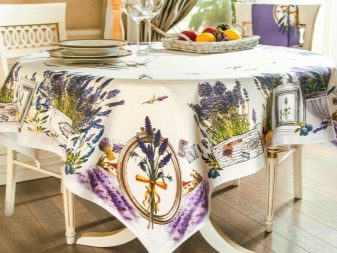
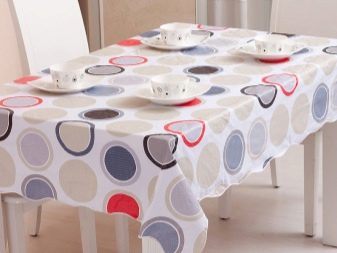
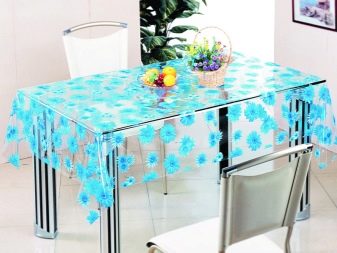
Oilcloth is optimal for use in the country - it is good both in the house and in the summer kitchen. The glued coating is not afraid of rain and ultraviolet rays, retaining its aesthetic appearance and functionality in all weather conditions.
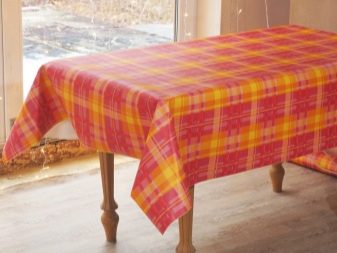

Polyester - another practical material at an affordable price, but at the same time significantly superior to oilcloth in appearance and design. The tablecloth from it looks much more solid. As a rule, it is decorated with a variety of patterns and decorative frills.
The advantages of polyester include the fact that it hardly gets dirty, does not deform and easily tolerates washing in a washing machine. This option is usually used as an everyday option, and thanks to the variety of designs, you can always find a model that is suitable for kitchens with any interior.

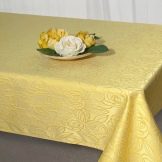
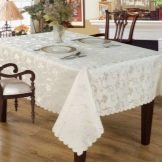

Cotton is a linen material that can be dense and thin, patterned and monotonous... The tablecloth from it falls in smooth folds, and therefore looks extremely noble and stylish. Usually, cotton with a water-repellent coating is used for the kitchen countertop - it prevents the penetration of liquids into the fibers, so the tablecloth can be easily cleaned of almost any kind of dirt.
For example, it is very popular among housewives teflon and acrylic tablecloths - these fabrics can withstand washing even at elevated temperatures with the use of synthetic bleaches. Teflon impregnation does not deform under the influence of hot dishes and is hygienic. but with frequent washing, the protective sheet becomes thinner and ceases to fulfill its functions.
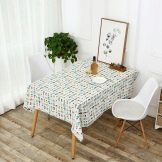


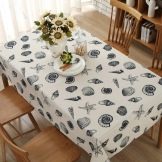
Linen - a rather delicate material with an interesting texture, which always looks solid and impressive. But this material has a serious drawback - it gets dirty very quickly, but stains are very difficult to remove from it.
Undoubtedly, a coating of flax with a moisture-repellent impregnation is the dream of any housewife, but, to their great regret, no protective agents are applied to this material.
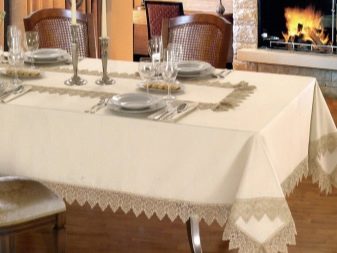
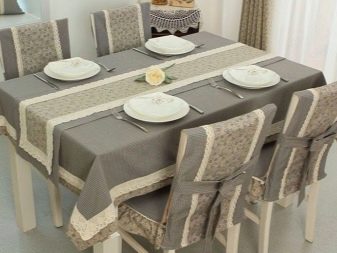
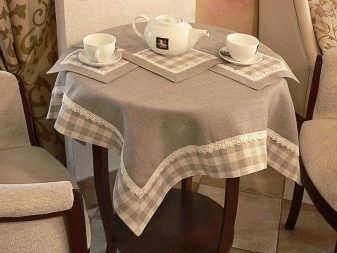
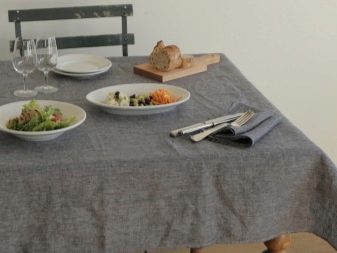
Jacquard - a characteristic feature of this material is its design on both sides. It can be said that the jacquard coating represents two decor options that differ from each other. Usually, the front and back patterns differ from each other in texture and care.
Jacquard in any situation looks luxurious, aristocratic and noble. In addition, it changes the look of the kitchen almost beyond recognition. This material is especially good for those who do not like the mundane - changing the style of the room is easy just by turning the model upside down. The material itself is very dense, easily tolerating multiple washes in a typewriter.
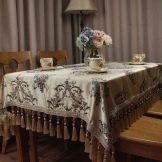
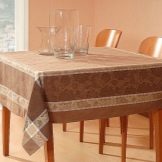
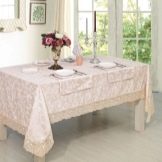
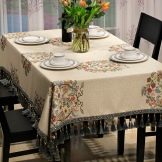
Silk tablecloths are usually suitable for creating multi-layered draperies that give the kitchen a truly rich and effective look, but this cloth is not recommended for daily use, since this fabric is impractical, very demanding and quite expensive.
Often, tablecloths are not sewn from natural linen, but with the addition of polyester. Such textiles outwardly look flawless, but the strength and resistance of the material to wear increases many times over.
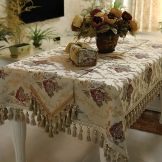

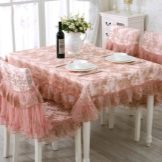

Viscose - a synthetic material made from wood fibers. It is usually used for sewing tablecloths either neat or as part of some canvases. Such products are easily draped, as a rule, pleasant to the touch and beautifully colored. Of the minuses of viscose, it can be noted that it wrinkles quickly and strongly.
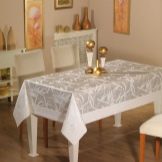
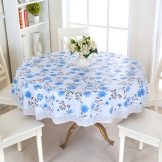
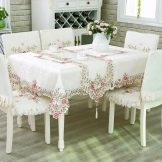
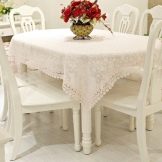
For everyday use, jute can be used, as well burlap... These fabrics with a stylish rough texture that blend harmoniously with kitchen interiors, decorated in loft or shabby chic decors. Such coatings look quite stylish, however, it is better to use them in combination with hot coasters to avoid frequent intensive washing.
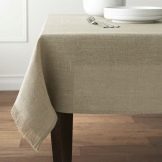
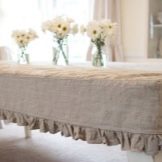

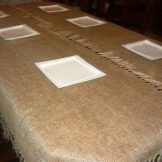
Sizes and shapes
Tablecloths are produced in a wide variety of designs.
- Round. These are the traditional options that are used for round or slightly oval tables.
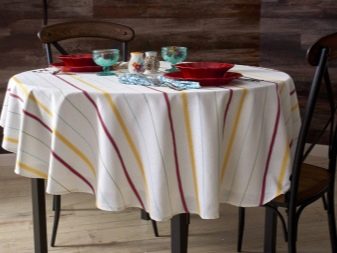
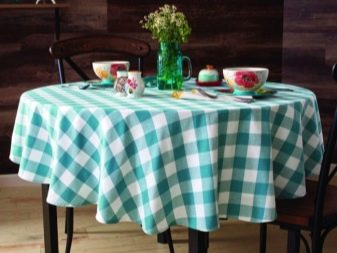
- Oval. Suitable for festive decor. As a rule, they are complemented with a graceful lace fringe at the bottom, making the cover looks sophisticated and stylish.
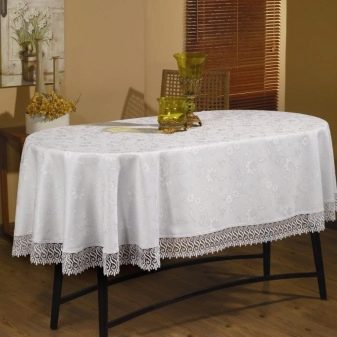
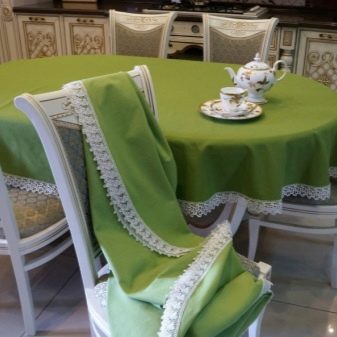
- Rectangular and square... Pretty practical everyday options. It is noteworthy that they are used not only on quadrangular tables.For example, a square model looks very harmonious on a round table top.

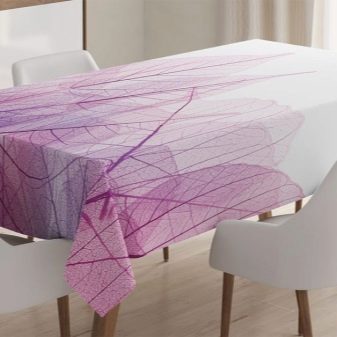
It is very important to accurately determine the size. In accordance with the standards, the tablecloth should be slightly larger than the working area of the tabletop, but not less than 20%. And if the model is used for a gala banquet, the difference should exceed 70%, hanging almost to the floor.
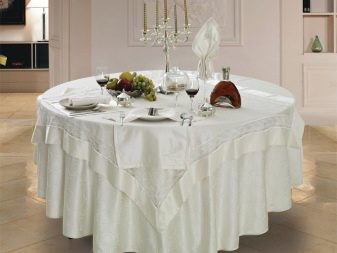
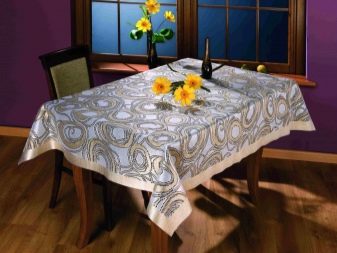
The minimum acceptable tablecloth sizes are:
- for everyday use, the canvas should hang by about 20-30 cm;
- for a more important and significant event - 30-40 cm;
- for a banquet - more than 40 cm;
- in the event of a gala reception, the canvas should hang down to the floor.
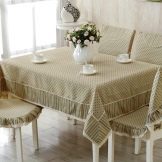
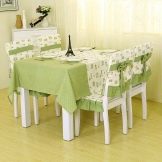
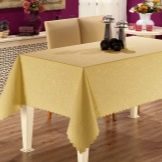

Colors and design
Tablecloth colors and decors largely depend on the characteristics of its use. Traditionally, they are conventionally divided into two types.
- Everyday - they are usually made from the simplest inexpensive materials with a special water-repellent and protective coating. They can be functional, for example, tea, dining or decorative - in this case, they are used to create spectacular accents in the interior.
- Festive - elegant coverings, sewn from expensive canvases, decorated with decors and having an interesting texture and relief. These tablecloths are suitable for special occasions. And also on sale there are often models with children's prints, New Year's or romantic themes.
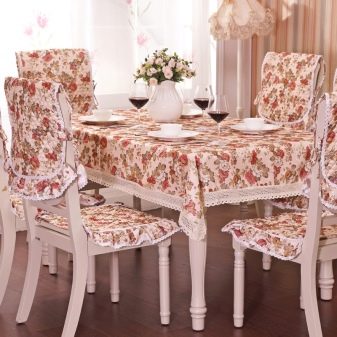
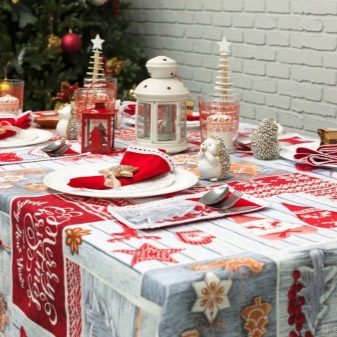
As for the color scheme, the choice should be made taking into account the peculiarities of the general design of the room.
- White - usually used both daily and for holidays.
- Light, delicate shades (pastel, light green, pistachio, coffee with milk, blue) - look harmonious with everyday use. These shades are harmonious in an Empire or Baroque kitchen.
- Bright colors, rainbow colors - will be a good addition to a thematic or children's party.
- Dark tones noble colors are usually combined with classic and neoclassical cuisines in a prim English style.
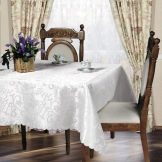
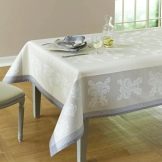
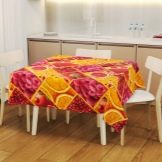
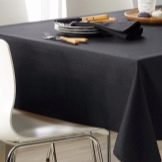
Modern tablecloths are distinguished by a wide variety of patterns, and the choice is made in accordance with the style and design of the dining room and the reason for the meal. Typically, the following decors are found.
- Cell. It can be small or large, made in a variety of colors. Usually such tablecloths are purchased for Provence or country style kitchens, they are optimal for everyday use.
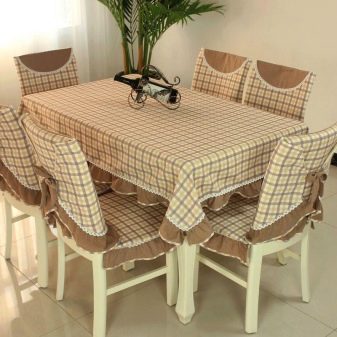

- Stripes. These decors perfectly complement the Scandinavian style concept in the kitchen interior. Bright stripes are appropriate for party decoration, while faded ones are good for everyday use.
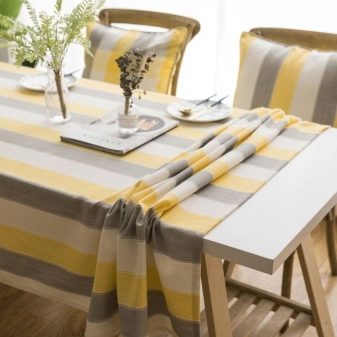
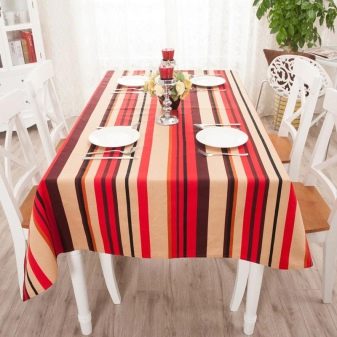
- Flowers. Tablecloths with flowers always create coziness, bring fresh notes to the room, so many housewives like it.
Keep in mind that small flowers work best in Provence or shabby chic dining rooms, while large prints will add dramatic accents to country kitchens.
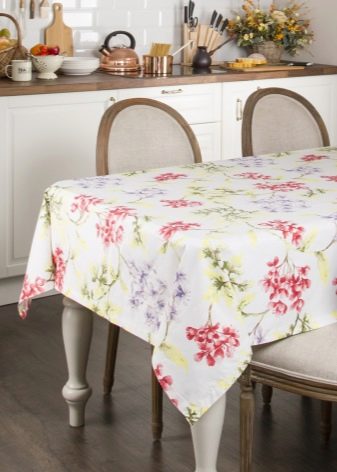

- Geometric abstraction. Usually such options are used for a successful table setting. In addition, these decors are optimal for business meetings in an informal setting.
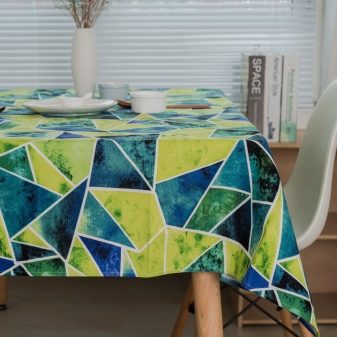
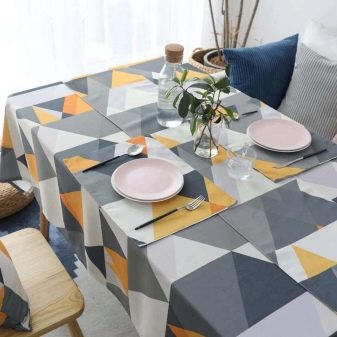
- Patterns around the edge of the cover will become a real boon for interiors in the Baroque style, since such a design involves embroidery with silver or golden threads along the edges. A barely noticeable pattern is optimal for the English style - in this case, the tablecloth can be covered for festive events.
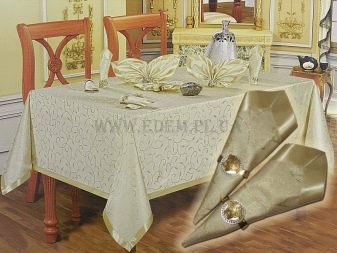
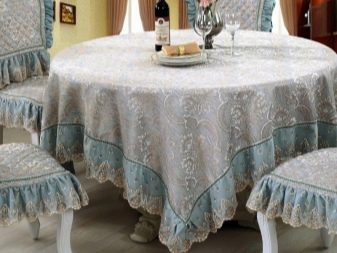
- Embroidery, braid, ruffles, lace. This is a spectacular option for additional decoration of tablecloths that looks good and creates coziness in the house. Similar products are used for kitchens in shabby chic and country styles.
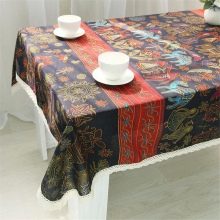

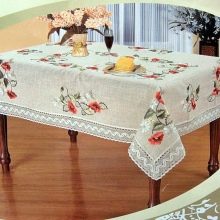
- Patchwork. These tablecloths are made using the patchwork technique - they look harmonious in kitchens decorated in a rustic or Scandinavian style.
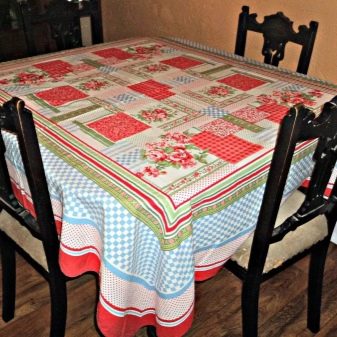
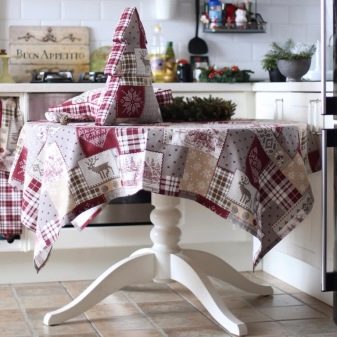
How to choose?
The choice of tablecloths for the kitchen table is great - in stores you can find transparent silicone and "glass" models, thermocloths, products made of PVC film, "flexible glass" and even plastic.
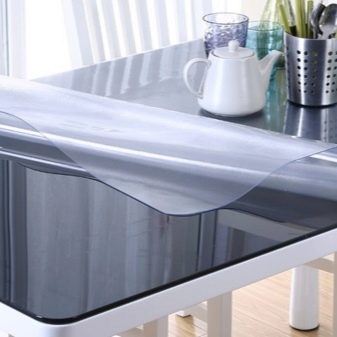
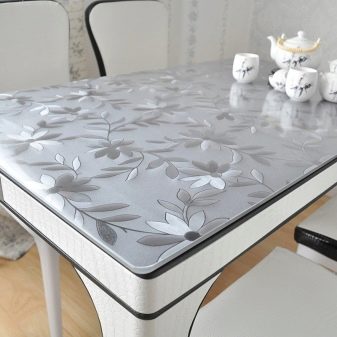
To choose the right tablecloth, you need to follow a few simple guidelines.
- The tablecloth must be in harmony with anything in the dining room. If you purchase a model of a certain color and this color scheme will no longer be duplicated in the room, then such a tablecloth will not look aesthetically pleasing. Therefore, when choosing a tablecloth, be sure to look out for pillows on a chair, towels and any other textile items to match.
- Choose a tablecloth that matches the table shape. If you have a round table, then it needs a round tablecloth, but if the table is square, then the tablecloth, of course, should be square. Keep in mind that a rectangle laid out on an oval plane will not look as impressive as you expect.
- For frequent use, be sure to lay an impregnated tablecloth, even if you put special coasters under the hot. Otherwise, constant washing awaits you, and this contributes to the rapid wear of the material.
- It is necessary to select the fabric for banquets taking into account the characteristics of the material. As a rule, the festive table is often supplemented with candles, and any falling spark can cause a fire if the coating is made, for example, of synthetics. In this case, it is worth making a choice in favor of flax - if a spark hits it, it immediately goes out, in most cases without leaving even a trace on the surface.
- Pay attention to the drying time of the material. Synthetics have no equal in this parameter. A synthetic tablecloth is quickly erased, stains do not eat into it, and it dries after washing in just a few minutes. That is why the material is indispensable for everyday use, but for solemn occasions this ability is useless - holidays do not happen as often as we would like, so the tablecloth can dry for at least a week.
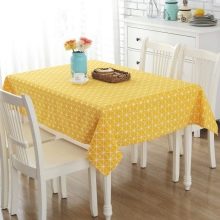
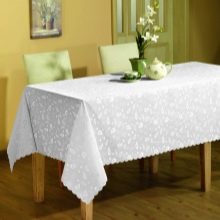
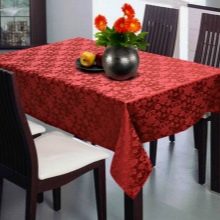
Successful examples
A well-chosen tablecloth is essential for creating warmth and comfort in your home. It is a stylish component of any family or friends gathering, so it is very important to decide on its color, decor and texture.
If the dining room is done in a classic and neoclassical style, a light linen tablecloth will be ideal. And also it will be an excellent decoration for a massive wooden table. In addition to linen, you can pick up interesting models made of cotton or synthetics.
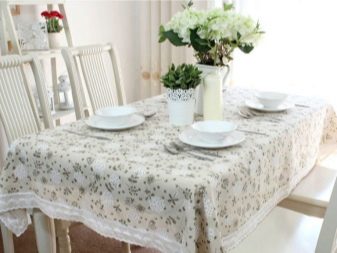
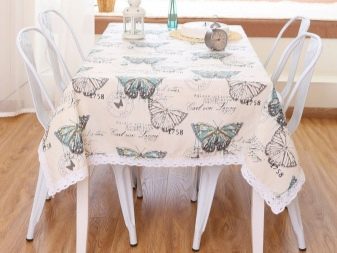
Jacquard coatings look really impressive.
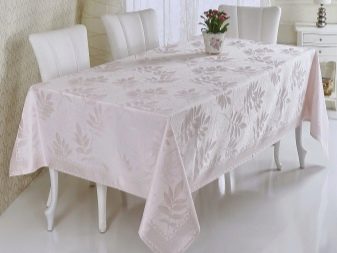
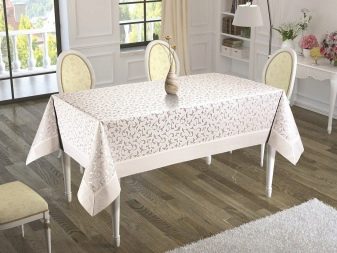
For everyday use, they purchase expensive coatings made of synthetic materials - oilcloth, polyester. The days when these materials were boring and monotonous are long gone. Today you can always find a wide selection of models for a very different taste, style and color.
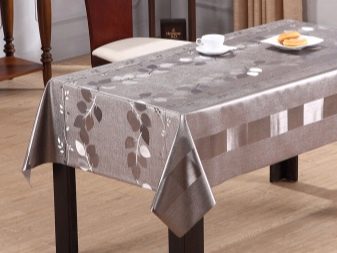
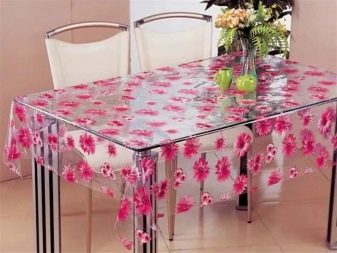
For information on how to choose the right tablecloths for the kitchen, see the video below.








